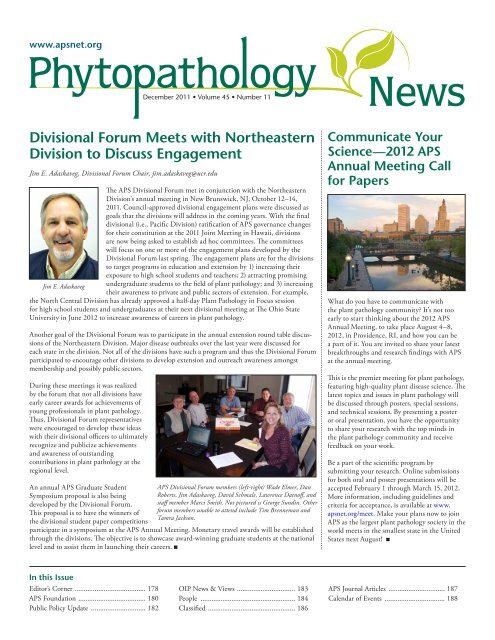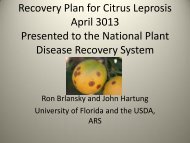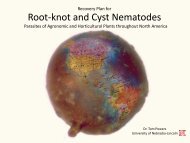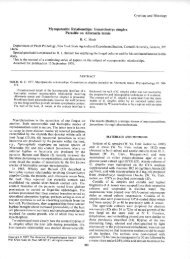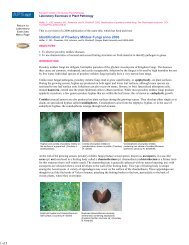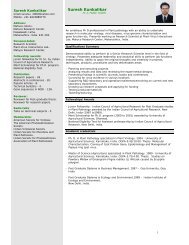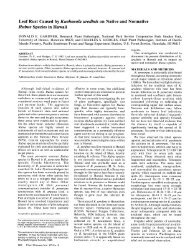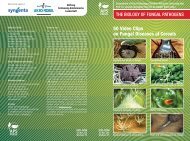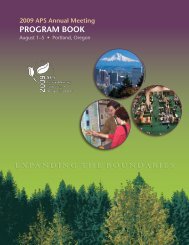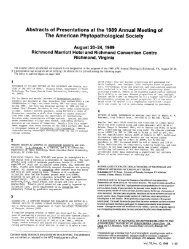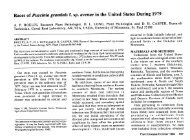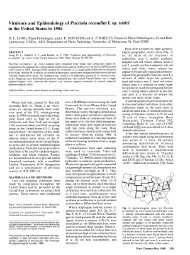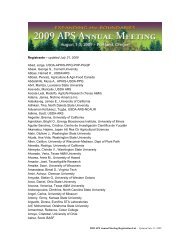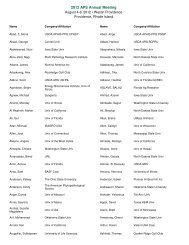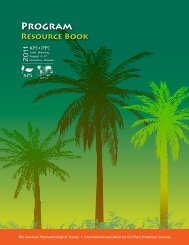Phytopathology News - American Phytopathological Society
Phytopathology News - American Phytopathological Society
Phytopathology News - American Phytopathological Society
You also want an ePaper? Increase the reach of your titles
YUMPU automatically turns print PDFs into web optimized ePapers that Google loves.
www.apsnet.org<br />
Divisional Forum Meets with Northeastern<br />
Division to Discuss Engagement<br />
Jim E. Adaskaveg, Divisional Forum Chair, jim.adaskaveg@ucr.edu<br />
The APS Divisional Forum met in conjunction with the Northeastern<br />
Division’s annual meeting in New Brunswick, NJ, October 12–14,<br />
2011. Council-approved divisional engagement plans were discussed as<br />
goals that the divisions will address in the coming years. With the final<br />
divisional (i.e., Pacific Division) ratification of APS governance changes<br />
for their constitution at the 2011 Joint Meeting in Hawaii, divisions<br />
are now being asked to establish ad hoc committees. The committees<br />
will focus on one or more of the engagement plans developed by the<br />
Divisional Forum last spring. The engagement plans are for the divisions<br />
to target programs in education and extension by 1) increasing their<br />
exposure to high school students and teachers; 2) attracting promising<br />
Jim E. Adaskaveg undergraduate students to the field of plant pathology; and 3) increasing<br />
their awareness to private and public sectors of extension. For example,<br />
the North Central Division has already approved a half-day Plant Pathology in Focus session<br />
for high school students and undergraduates at their next divisional meeting at The Ohio State<br />
University in June 2012 to increase awareness of careers in plant pathology.<br />
Another goal of the Divisional Forum was to participate in the annual extension round table discussions<br />
of the Northeastern Division. Major disease outbreaks over the last year were discussed for<br />
each state in the division. Not all of the divisions have such a program and thus the Divisional Forum<br />
participated to encourage other divisions to develop extension and outreach awareness amongst<br />
membership and possibly public sectors.<br />
During these meetings it was realized<br />
by the forum that not all divisions have<br />
early career awards for achievements of<br />
young professionals in plant pathology.<br />
Thus, Divisional Forum representatives<br />
were encouraged to develop these ideas<br />
with their divisional officers to ultimately<br />
recognize and publicize achievements<br />
and awareness of outstanding<br />
contributions in plant pathology at the<br />
regional level.<br />
An annual APS Graduate Student<br />
Symposium proposal is also being<br />
developed by the Divisional Forum.<br />
This proposal is to have the winners of<br />
the divisional student paper competitions<br />
participate in a symposium at the APS Annual Meeting. Monetary travel awards will be established<br />
through the divisions. The objective is to showcase award-winning graduate students at the national<br />
level and to assist them in launching their careers. n<br />
In this Issue<br />
Editor’s Corner ....................................... 178<br />
APS Foundation ..................................... 180<br />
Public Policy Update .............................. 182<br />
December 2011 • Volume 45 • Number 11<br />
APS Divisional Forum members (left-right) Wade Elmer, Dan<br />
Roberts, Jim Adaskaveg, David Schmale, Lawrence Datnoff, and<br />
staff member Marci Smith. Not pictured is George Sundin. Other<br />
forum members unable to attend include Tim Brenneman and<br />
Tamra Jackson.<br />
OIP <strong>News</strong> & Views ................................ 183<br />
People .................................................... 184<br />
Classified ................................................ 186<br />
<strong>News</strong><br />
Communicate Your<br />
Science—2012 APS<br />
Annual Meeting Call<br />
for Papers<br />
What do you have to communicate with<br />
the plant pathology community? It’s not too<br />
early to start thinking about the 2012 APS<br />
Annual Meeting, to take place August 4–8,<br />
2012, in Providence, RI, and how you can be<br />
a part of it. You are invited to share your latest<br />
breakthroughs and research findings with APS<br />
at the annual meeting.<br />
This is the premier meeting for plant pathology,<br />
featuring high-quality plant disease science. The<br />
latest topics and issues in plant pathology will<br />
be discussed through posters, special sessions,<br />
and technical sessions. By presenting a poster<br />
or oral presentation, you have the opportunity<br />
to share your research with the top minds in<br />
the plant pathology community and receive<br />
feedback on your work.<br />
Be a part of the scientific program by<br />
submitting your research. Online submissions<br />
for both oral and poster presentations will be<br />
accepted February 1 through March 15, 2012.<br />
More information, including guidelines and<br />
criteria for acceptance, is available at www.<br />
apsnet.org/meet. Make your plans now to join<br />
APS as the largest plant pathology society in the<br />
world meets in the smallest state in the United<br />
States next August! n<br />
APS Journal Articles ............................... 187<br />
Calendar of Events ................................. 188
www.apsnet.org<br />
December 2011 • Volume 45 • Number 11<br />
Editor-in-Chief: Doug Jardine<br />
Managing Editor: Michelle Bjerkness<br />
Editor: Amanda Aranowski<br />
Design: Agnes Walker<br />
Advertising Sales: Cindy Anderson<br />
<strong>Phytopathology</strong> <strong>News</strong> (ISSN 0278-0267) is published eleven<br />
times per year by The <strong>American</strong> <strong>Phytopathological</strong> <strong>Society</strong> (APS)<br />
at 3340 Pilot Knob Road, St. Paul, MN 55121 U.S.A. Phone:<br />
+1.651.454.7250, Fax: +1.651.454.0766, E-mail: aps@scisoc.org,<br />
Web: www.apsnet.org. <strong>Phytopathology</strong> <strong>News</strong> is distributed to all<br />
APS members. Subscription price to nonmembers is $69 U.S./$81<br />
Elsewhere. Periodicals paid at St. Paul, MN. CPC Intl Pub Mail<br />
#0969249. Postmaster: Send address changes to <strong>Phytopathology</strong><br />
<strong>News</strong>, 3340 Pilot Knob Road, St. Paul, MN 55121 U.S.A.<br />
Submission Guidelines<br />
Address all editorial correspondence to: Doug Jardine, Department<br />
of Plant Pathology, 4024 Throckmorton Hall, Kansas State University,<br />
Manhattan, KS, 66506-5502 U.S.A. Phone: +1.785.532.1386;<br />
Fax: +1.785.532.5692; E-mail: Phyto<strong>News</strong>Editor@scisoc.org. In<br />
order to ensure timely publication of your news items and announcements,<br />
please send in material six weeks prior to the date of<br />
publication. Material should be no more than six months old when<br />
submitted. Submission of materials as electronic files, via e-mail,<br />
will speed processing. For information on submitting electronic<br />
images contact Agnes Walker at awalker@scisoc.org. Deadline for<br />
submitting items for the January 2012 issue is November 15, 2011.<br />
APS Leadership<br />
Council<br />
President: Carol A. Ishimaru<br />
President-Elect: Michael J. Boehm<br />
Vice President: George S. Abawi<br />
Immediate Past President: John L. Sherwood<br />
Internal Communications Officer: David M. Gadoury<br />
Treasurer: Randall C. Rowe<br />
Treasurer-Elect: Steven A. Slack<br />
Senior Councilor-at-Large: Anne E. Dorrance<br />
Intermediate Councilor-at-Large: Walter F. Mahaffee<br />
Junior Councilor-at-Large: Jeff B. Jones<br />
Divisional Councilor: David G. Schmale III<br />
Publications Councilor: Anthony P. Keinath<br />
Executive Vice President: Steven C. Nelson<br />
Editors-in-Chief<br />
APS PRESS: Margery L. Daughtrey<br />
MPMI: Gary Stacey<br />
<strong>Phytopathology</strong>: Niklaus J. GrÜnwald<br />
<strong>Phytopathology</strong> <strong>News</strong>: Doug J. Jardine<br />
Plant Disease: R. Mike Davis<br />
Plant Disease Management Reports: Frank P. Wong<br />
Plant Health Progress: Ned A. Tisserat<br />
The Plant Health Instructor: Anton B. Baudoin<br />
Board and Office Chairs and Directors<br />
APS Foundation Chair: Ray D. Martyn<br />
Divisional Forum Chair: Jim E. Adaskaveg<br />
PPB Chair: Jan E. Leach<br />
Publications Board Chair: Anthony P. Keinath<br />
OE Director: Scott E. Gold<br />
OEC Director: Seogchan Kang<br />
OIP Director: Sally A. Miller<br />
OIR Director: Brian D. Olson<br />
OPRO Director: Monica L. Elliott<br />
AMB Director: Scott T. Adkins<br />
AXMB Director: Rick Bennett<br />
Division Officers<br />
Caribbean<br />
Divisional Forum Rep.: Lawrence Datnoff<br />
President: Ronald D. French-Monar<br />
Vice President: Judith K. Brown<br />
Secretary-Treasurer: Aaron Palmateer<br />
North Central<br />
Divisional Forum Rep.: Tamra Jackson<br />
President: Anne Dorrance<br />
Vice President: James Stack<br />
Secretary-Treasurer: Carl Bradley<br />
Northeastern<br />
Divisional Forum Rep.: Wade H. Elmer<br />
President: Beth K. Gugino<br />
Vice President: Christian A. Wyenandt<br />
Secretary-Treasurer: David C. Thompson<br />
Pacific<br />
Divisional Forum Rep.: Jim E. Adaskaveg<br />
President: Debra A. Inglis<br />
President-Elect: Themis Michailides<br />
Secretary-Treasurer: Akif Eskalen<br />
Potomac<br />
Divisional Forum Rep.: Daniel Roberts<br />
President: Boris A. Vinatzer<br />
Vice President: Yilmaz Balci<br />
Secretary-Treasurer: Bingyu Zhao<br />
Southern<br />
Divisional Forum Rep.: Timothy B. Brenneman<br />
President: David Langston<br />
President-Elect: Raymond W. Schneider<br />
Vice President: Jason Woodward<br />
Secretary-Treasurer: Donald M. Ferrin<br />
178 <strong>Phytopathology</strong> <strong>News</strong><br />
<strong>News</strong><br />
Editor’s Corner<br />
Is There a Tricorder in Your Future?<br />
Doug Jardine, Kansas State University, Phyto<strong>News</strong>Editor@scisoc.org<br />
For anyone who was or is a Star Trek fan, you would know that a tricorder<br />
was a fictional, multifunction device used for sensor scanning, data analysis,<br />
and recording data. Mr. Spock wouldn’t think of exploring a planetary<br />
surface without one, and Dr. McCoy was able to make on-the-spot,<br />
detailed medical diagnoses by waving his handheld version over the<br />
patient. After attending the recent Third National Meeting of the National<br />
Plant Diagnostic Network (NPDN), I am not so sure that a crude, but<br />
functional, tricorder-like device for plant pathology diagnosticians is not all<br />
that far off in the future.<br />
The theme of the conference was “Next Gen NPDN.” The opening<br />
Doug Jardine symposium was “New Technologies in Diagnostics.” Topics included<br />
loop-mediated isothermal amplification, next-generation sequencing for<br />
identification of plant pathogens, DNA chip arrays for virus identification, and the potential of<br />
microfluidic systems for diagnostics in plant pathology. Can you imagine doing PCR in a device<br />
about the size of your smart phone? Testing for multiple pathogens in a plant sample at a cost of a few<br />
pennies a run? The possibilities are closer than you think!<br />
One of the most interesting presentations at the conference was by Arturo Casadevall, Einstein<br />
College of Medicine, who presented a paper entitled “Emerging fungal pathogens—Past, present, and<br />
future.” One of his discussion points was why is it, when there are approximately 1.5 million species<br />
of fungi, only about 150 are pathogenic to humans? Hint: It has to do with our body temperature and<br />
why we have to eat so much compared to reptiles for instance, that may only eat once a week.<br />
If you weren’t one of the nearly 200 plant pathologists in attendance, you are in luck as many of the<br />
presentations were videotaped and will be made available on the NPDN website at www.NPDN.<br />
org. To sum up the conference, I turn to one of Mr. Spock’s most frequently repeated quotes,<br />
“Fascinating!” n<br />
Submissions Due Soon for PDMR Volume 6 (2012)<br />
As in the past, Plant Disease Management Reports (PDMR) will be published in two installments,<br />
allowing authors to submit reports twice a year. Submissions to the first installment are due to<br />
the editor-in-chief for assignment by December 5, 2011. Publication charges are $40 per report<br />
and are payable with submission of the final approved report by February 20, 2012. Instructions<br />
for submission preparation and procedure and an online submission form are available at<br />
www.scientificsocieties.org/aps/pdmr/guidelines. n<br />
2010 Art in <strong>Phytopathology</strong> Submission:<br />
Mike’s Nose<br />
Robin Choudhury, University of California-Davis<br />
I took this photo in Blacksburg, VA, where an<br />
annual Halloween carving party occurs each year.<br />
The owner of the property, Mike, has several acres of<br />
land, and this locust tree was near the entrance. He<br />
had jokingly added the eyes and mouth to the conch,<br />
making it look like a face. I was an undergraduate at<br />
University of Maryland at the time, and my former<br />
plant pathology teacher (Yilmaz Balci) identified the<br />
fungus as Phellinus robiniae. n
Impressive, Dedicated APS Community<br />
Continues to Grow<br />
Thank You<br />
Volunteers are at the heart of APS’s success; we simply<br />
could not produce the exceptional experiences, vibrant<br />
community, and essential tools that we all value without<br />
the contributions of members’ time, talent, and expertise.<br />
Special thanks to the more than 900 members who shared their skills, passion, and diverse<br />
perspectives this past year. Together, we are accomplishing significant goals for APS and furthering<br />
the plant pathology profession.<br />
According to the 2011 APS Membership Survey, members are eager to volunteer and the percentage<br />
of members who volunteer is growing. In addition, the amount of time members give is on the<br />
rise, and those indicating interest in participating in the future is also increasing, with early career<br />
professionals, along with student/post-doc members and those in developing countries, showing the<br />
most interest.<br />
What an impressive, dedicated community! Opportunities exist at various levels of engagement and<br />
across the full spectrum of the society. Make sure to share your talents with APS in the year ahead<br />
and continue to impact the future of plant pathology! n<br />
Actively Engage in APS and Expand Your<br />
Leadership Experiences<br />
Looking for an opportunity to actively engage in APS? Interested in a leadership experience that<br />
will provide the unique opportunity to impact the future of plant pathology? Or perhaps you<br />
have a colleague who has the skill set and interest in an advanced service-learning opportunity?<br />
Now is your chance, as a member of APS, to nominate your colleagues or indicate your own<br />
interest in service to APS for vice president or councilor-at-large on APS Council.<br />
On November 8, an e-mail requesting participation was sent to all APS members. To<br />
submit your nominations, simply use the web form at http://surveys.qualtrics.com/<br />
SE/?SID=SV_1NQoHHT25jeqHWY. (Paper nomination ballots were only sent to those members<br />
without an e-mail address on file at APS Headquarters.) All nominations must be received on or<br />
before Tuesday, December 6, 2011. Members may either self-nominate or they may be nominated<br />
by others. Keep in mind that for your nominations to be considered for the 2012 APS Council<br />
election, nominees will also need to complete an application form by January 20, 2012. Additional<br />
details are available at www.apsnet.org/members/apsleadership/Pages/APSCouncilNominations.aspx.<br />
Your involvement in this process is important, submit your nominations today! n<br />
Food Safety Starts with Healthy Plants!<br />
2012 Human Pathogens on Plants Workshop<br />
Share strategies, perspectives, and<br />
expertise while shaping the future of<br />
research for human pathogens on plants.<br />
February 13–15, 2012<br />
Hyattsville, Maryland, U.S.A.<br />
The <strong>American</strong> <strong>Phytopathological</strong> <strong>Society</strong><br />
www.apsnet.org/hppw<br />
#8606-11/2012<br />
COMMITTEE SPOTLIGHT<br />
Collections and<br />
Germplasm<br />
Committee<br />
Shuxian Li, Collections and Germplasm<br />
Committee Chair, shuxian.li@ars.usda.gov,<br />
and Rick Bennett, Collections<br />
and Germplasm Committee vice chair,<br />
rbennett@uark.edu<br />
The mission of the Collections and<br />
Germplasm Committee is to promote<br />
and foster the collection, preservation,<br />
improvement, and utilization of U.S. and<br />
international resources of microbial and<br />
higher-plant germplasm; identify issues<br />
relevant to germplasm resources; advocate<br />
judicious improvements in collection and<br />
germplasm systems; and constructively<br />
influence policies and procedures through<br />
APS Council by such means as committee<br />
proposals, APS publications and discussion<br />
sessions, and communications with other<br />
scientific societies, governmental agencies,<br />
institutions, and industry.<br />
Collections of plant pathogens have played<br />
important roles in the advancement of<br />
plant pathology and related fields. They<br />
provide critical links between past and<br />
present disease epidemics, facilitate<br />
identification of emerging diseases, and<br />
are useful in developing control strategies<br />
for plant diseases. However, the collection<br />
of plant pathogens in the nation lacks a<br />
coordinated national system to protect,<br />
preserve, and enhance these valuable<br />
resources. Currently, the key issue our<br />
committee is focusing on is support for the<br />
establishment of a national plant microbial<br />
germplasm system (NPMGS) to protect<br />
endangered collections and teach good<br />
collection practices.<br />
Members of the committee sponsor<br />
symposia and workshops at APS meetings<br />
that address issues related to culture<br />
collections and germplasm and sponsored<br />
a hands-on workshop entitled “Microbial<br />
Collections: Practice and Management”<br />
on August 5, 2011, at the APS-IPPC Joint<br />
Meeting in Honolulu, HI. n<br />
<strong>Phytopathology</strong> <strong>News</strong> 179
Call for Applications<br />
for 2012 Storkan-<br />
Hanes-McCaslin<br />
Foundation Awards<br />
The Storkan-Hanes-McCaslin Foundation<br />
Awards are named in honor of Richard C.<br />
Storkan, Gerald L. Hanes, and Robert L.<br />
McCaslin. Each had a long history of<br />
cooperation with the scientific community,<br />
and were pioneers in developing effective soil<br />
fumigation through experimental research.<br />
The foundation was established in 1987 to support<br />
graduate student research. To date, more<br />
than $366,000 has been awarded to 63 promising<br />
scientists. In addition to unrestricted cash awards<br />
(which range from $5,000 to $10,000 and can be<br />
used for any purpose that will benefit the education<br />
of the student, including personal expenses),<br />
new awardees will also receive round-trip fares to<br />
the APS Annual Meeting and are presented their<br />
awards at a luncheon attended by their research<br />
advisors, previous awardees, and members of the<br />
Foundation Committee. The research for which<br />
the award is given is expected to be performed<br />
by the applicant during the academic year 2012–<br />
2013 and a one-page progress report is due one<br />
year from the date of the award. It would be appreciated<br />
if the foundation were acknowledged in<br />
research publications stemming from this award.<br />
A major aim of the foundation is to encourage<br />
research by offering financial assistance to<br />
graduate students who are working on soilborne<br />
diseases of plants. The research must be done in<br />
the United States. Foundation policy is to contribute<br />
to the education of the student. Grants<br />
are made on a yearly basis and may be renewed<br />
upon review by the committee.<br />
Applications must be received before May 1,<br />
2012, for funding to begin September 1, 2012.<br />
Please submit six copies each of a short, two- to<br />
three-page research proposal containing a concise<br />
statement of the objectives, methods and<br />
materials, and projected impact of the proposed<br />
research; a one-page resume (i.e., a brief education<br />
and research background, including a telephone<br />
number and e-mail address); and a letter from<br />
the applicant’s major professor or research<br />
director. A budget is not required. Preference<br />
will be given to those proposals containing<br />
innovative, creative, and/or novel research<br />
approaches to the stated objective(s) and to the<br />
overall quality (organization, correct grammar,<br />
and spelling) of the written proposal. Send<br />
applications to A. Paulus, Chair Selection<br />
Committee, Storkan-Hanes-McCaslin<br />
Foundation, Department of Plant Pathology<br />
and Microbiology, University of California,<br />
Riverside, CA 92521-0122. If further details<br />
are desired, Paulus can be reached by<br />
e-mail at albert.paulus@ucr.edu or by phone<br />
at +1.951.827.3431. n<br />
180 <strong>Phytopathology</strong> <strong>News</strong><br />
APS Foundation<br />
Introduce Undergrads to Plant Pathology<br />
Research with a Frank L. Howard Fellowship<br />
Do you have undergraduate students working in your laboratory who could benefit from the support<br />
of the Frank L. Howard Undergraduate Fellowship? If so, we encourage you to notify them about<br />
this opportunity. The application process is not complicated and it provides an excellent opportunity<br />
to introduce an undergraduate to the exciting world of plant pathology research.<br />
The fellowship will be awarded for summer 2012 or the 2012–2013 academic school term. One<br />
award of $1,000 will be made to support undergraduate research and may be used for stipend and<br />
research budget expenses. The sponsor or student should plan to present the results of their research<br />
at a regional or national APS meeting following completion of the research.<br />
Undergraduate students are encouraged to apply immediately. Six copies of the application package<br />
are due January 24, 2012. Applications and instructions can be found at www.apsnet.org/<br />
members/foundation/apply/Pages/UndergradFellowship.aspx.<br />
If you have any questions, please feel free to contact Mani Skaria, Texas A&M University,<br />
Kingsville Citrus Center, by phone +1.956.447.3368 or via e-mail at mani.skaria@tamuk.edu. n<br />
Graduate Student Funding Opportunities<br />
Mark your calendars and plan to submit your applications for the Raymond J. Tarleton Student<br />
Fellowship and/or the I. E. Melhus Graduate Student Symposium. These APS Foundation awards<br />
provide unique opportunities for student plant pathologists to support their research and increase<br />
their participation in APS activities.<br />
The Raymond J. Tarleton Student Fellowship can be used as a stipend for research expenses, books,<br />
research or scientific meeting travel, summer internships, and/or equipment. Applications are being<br />
accepted through January 13, 2012. One award of $1,500 is available; view full details at www.<br />
apsnet.org/members/foundation/apply/Pages/RaymondTarleton.aspx.<br />
The 2012 I. E. Melhus Graduate Student Symposium this year is focused on host plant resistance<br />
and disease management and will feature four graduate student presentations with travel awards<br />
for each presenter of $500 for the 2012 APS Annual Meeting. Applications are being<br />
accepted through January 9, 2012. View full details at www.apsnet.org/members/<br />
foundation/apply/Pages/IEMelhusGradStudentSymposium.aspx.<br />
Submit your applications and gain new opportunities and experiences through<br />
the support of the APS Foundation! n<br />
Creating Possibilities for Plant Pathology<br />
You can make an immediate and direct impact. With a donation to the APS<br />
Foundation, 97% of what you give goes to the cause you care about most—<br />
sustaining the profession and science of plant pathology.<br />
More than 1,500 contributors have already shown their support, making it<br />
possible to give more than 50 awards for a total of $36,000 of<br />
funding in 2011. Thank you donors! (Visit www.apsnet.org/<br />
members/foundation/contributors for a cumulative listing.)<br />
You can create possibilities for plant pathology too, make a<br />
donation today at www.apsnet.org/give.<br />
Be an advocate.<br />
Grow plant pathology.<br />
Give today.
Yes, we’ve got you covered ...<br />
There are many types of plant stress that defy easy,<br />
reliable, and fast field measurements. Opti-Sciences<br />
provides solutions for almost every type.<br />
The New OS1p- Capable of detecting most types of plant stress.<br />
� Early Water Stress in C and C plants<br />
3 4<br />
o<br />
� Heat Stress at 35 C and above in C 3and C 4plants<br />
� Cold, Pesticide, Chemical and Biological Stresses<br />
In a class by itself, the OS1p includes direct readout of �F/Fm’, ETR, Fv/Fm, Rapid<br />
light Curves, Quenching Measurements and more on its built-in color graphics screen.<br />
Compared to any other PAM chlorophyll fluorometer, you will not find a more cost<br />
effective solution with as much capability as the OS1p!<br />
Affordable Reliable Highly Portable<br />
LCpro+ A Truly field portable CO 2 - HO 2 Gas exchange photosynthesis<br />
measurement system. Ideal for the most exacting plant stress measurements:<br />
o<br />
� Heat Stress can be detected at 30 C and above<br />
� Combining Gas Exchange and Fluorescence offers unique insight into cold stress<br />
� Lighter weight systems reduces fatigue making extended field work easier<br />
The LCpro+ is a proven system from the oldest name in photosynthetic gas exchange,<br />
ADC BioScientific.<br />
In addition to standard carbon assimilation and transpiration measurements,<br />
environmental controls allow graphing of all parameters including light curves and<br />
A/Ci curves in the field.<br />
8 Winn Ave. Hudson, NH 03051<br />
www.optisci.com<br />
Tel: 603 883-4400<br />
Fax: 603 883-4410
Public Policy Update<br />
PPB Attends Plant Science Research Summit<br />
Jan Leach, PPB Chair, jan.leach@colostate.edu<br />
What research in plant science is needed in the next 10 years to improve global food supplies using<br />
sustainable approaches and increase our understanding of plant biology? To develop a united plan<br />
to address this question, a Plant Science Research Summit (Chevy Chase, MD; September 22–23,<br />
2011), organized by the <strong>American</strong> <strong>Society</strong> of Plant Biologists (ASPB), brought together 75 plant<br />
scientists as well as representatives of federal agencies, professional societies, grower organizations,<br />
and other stakeholders of plant science. APS was represented at the summit by Jan Leach, Public<br />
Policy Board (PPB) chair; Kellye Eversole (Eversole Associates); and Angela Records (Eversole<br />
Associates), public policy fellow.<br />
While the summit participants readily agreed that plant science is critical to solving the global food<br />
needs, the discussions of “how” and “what is needed” were broad. One key, as summarized in the<br />
Science Insider (http://news.sciencemag.org/scienceinsider/2011/09/decadal-plan-for-plant-science.<br />
html), is that “Progress will require new model systems, intensively studied species that provide<br />
insights useful both in basic and applied research.” The importance of including crop species as<br />
models and the tools and information needed to accelerate characterization of the fundamental<br />
biological processes important to agriculture were discussed. The need to understand plant<br />
genetic diversity and plant-microbe interactions (beneficial and pathogenic) for improvement of<br />
economically useful plants was also discussed.<br />
Not surprisingly, no common path for plant science emerged from this two-day summit. However,<br />
Organizer Gary Stacey (ASPB) indicated that this summit was just the beginning. Over the next<br />
several months, a committee will work to capture the ideas from the summit and combine them with<br />
input submitted from the broad community to prepare a report that will provide a unified path for<br />
plant science and emphasize the critical role plant science plays in the nation’s future. The product,<br />
according to Stacey, will be a strong, single message that can guide future funding for plant sciences.<br />
We encourage you to participate in the process. You can follow progress at www.aspb.org/<br />
plantsummit and submit ideas there, or you can send suggestions to Leach (jan.leach@colostate.<br />
edu), Eversole (eversole@eversoleassociates.com), or Records (angela.records@gmail.com). n<br />
PPB Position Open with Regulatory Focus<br />
APS announces the availability of a position on the APS Public Policy Board (PPB) for a plant<br />
pathologist to focus on regulatory issues of interest to plant pathologists. For this position, PPB is particularly<br />
interested in plant pathologists with knowledge of regulatory issues at the EPA and APHIS.<br />
PPB seeks a person to continue productive initiatives related to regulatory issues, including the<br />
• establishment of an APS-APHIS partnership for risk-based regulations and e-Permitting to<br />
facilitate the movement of pathogens/pests intrastate and internationally;<br />
• identification of possible improvements in the risk-based permitting process for APS and<br />
associated societies;<br />
• efforts to provide the EPA with objective, science-based information for risk assessment on crop<br />
protection materials and biotechnology products for combating plant disease; and<br />
• submission of comments to USDA and the EPA on proposed regulations or guidances related to<br />
genetically engineered crops.<br />
Some newer areas of regulatory policy of interest to APS and PPB include<br />
• input on plant pathogens proposed for the Select Agent list; and<br />
• plant-pathology-relevant regulations from the U.S. Department of Health and Human Services<br />
(HHS) on synthetic biology.<br />
Interested individuals should review full details available at www.apsnet.org/<br />
members/apsleadership/Pages/VolunteerOpenings.aspx.<br />
PPB requests submission by December 20 of a short statement of interest and<br />
background (short CV) from members interested in serving APS as a PPB<br />
board member. Please send to PPB Chair Jan Leach at jan.leach@colostate.<br />
edu. Questions? E-mail or call Leach at +1.970.491.2924. n<br />
182 <strong>Phytopathology</strong> <strong>News</strong><br />
Field Crops Rust<br />
Symposium This<br />
Month!<br />
The <strong>American</strong> <strong>Phytopathological</strong> <strong>Society</strong> has<br />
created the first Field Crops Rust Symposium<br />
to be held December 14–16, 2011, in San<br />
Antonio, TX. Make time for this important<br />
event—registration and housing are now open.<br />
“The FCRS is unique in its focus; it’s intended<br />
to provide presentations of cutting-edge research<br />
on the rust diseases, but should also facilitate<br />
the exchange of ideas beyond the typical crop<br />
specific discussions,” said Erick DeWolf, Kansas<br />
State University.<br />
“In recent years, new races of rust have emerged<br />
that are causing serious problems in wheat, corn,<br />
and soybeans. These diseases are causing yield<br />
losses valued at more than $100 million annually,<br />
and aggravate global shortages of grain. It’s<br />
essential that the scientific community comes<br />
together to address these disease problems—<br />
nothing less than global food supply is at stake,”<br />
he added.<br />
The keynote will be given by Philip Pardey,<br />
University of Minnesota, concerning “Rust<br />
diseases within the larger context of food<br />
security.” The lecture will help the audience<br />
understand the fundamental issues related to<br />
food security and the hazards impacting global<br />
food production.<br />
Registration is now open. Find more information<br />
and the full program schedule online at<br />
www.apsnet.org/fcrs. The symposium is targeted<br />
at the scientific community, but commodity<br />
leaders, crop consultants, and others will also<br />
benefit from attending. Be a part of this<br />
symposium, be a part of the solution. n<br />
2011<br />
Field Crops Rust<br />
Symposium<br />
December 14-16, 2011<br />
San Antonio, Texas<br />
Registration &<br />
Housing Are Open<br />
Go to<br />
www.apsnet.org/fcrs<br />
to register now!
Learn Best<br />
Management Practices<br />
for Dealing with<br />
Common Scab<br />
Common scab is a disease that can persist<br />
indefinitely in some soils and affects all varieties<br />
of potatoes. This unsightly disease causes<br />
lesions on tubers, which lowers marketability<br />
and increases the costs of production and<br />
processing. The latest Focus on Potato webcast<br />
by Thomas Zitter, professor of plant pathology<br />
at Cornell University, addresses common<br />
scab and best management practices to deal<br />
with the disease. This presentation will help<br />
users get a broad overview of common scab<br />
and understand its associated symptoms;<br />
become aware of the difference between<br />
common scab and powdery scab; know the<br />
characteristics of organisms involved and<br />
specific in-field features of the disease; and<br />
learn best management practices for dealing<br />
with the disease. The presentation is available<br />
online at www.plantmanagementnetwork.<br />
org/edcenter/seminars/potato/CommonScab.<br />
Other presentations are available on<br />
the Focus on Potato website at www.<br />
plantmanagementnetwork.org/fop.<br />
Focus on Potato is a publication of the Plant<br />
Management Network (PMN), a nonprofit<br />
online publisher whose mission is to enhance<br />
the health, management, and production of<br />
agricultural and horticultural crops. It achieves<br />
this mission through applied, science-based<br />
resources. PMN is jointly managed by APS,<br />
<strong>American</strong> <strong>Society</strong> of Agronomy, and Crop<br />
Science <strong>Society</strong> of America. To take advantage<br />
of PMN’s full line of resources, please<br />
sign up for its free online newsletter at<br />
www.plantmanagementnetwork.org/update/<br />
default.cfm. n<br />
OIP <strong>News</strong> & Views<br />
Deadlines Approaching for JANE and<br />
International Travel Awards<br />
Proposals for the John and Ann Niederhauser Endowment (JANE) are due December 15,<br />
2011. One award of up to $5,000 for a project to take place during the 2012 calendar year will<br />
be provided. JANE was created to facilitate international cooperation related to research on and<br />
management of plant diseases, with particular emphasis on those caused by Phytophthora spp. To<br />
increase the award’s impact, the scope of projects to be considered has been expanded to include any<br />
international program in plant pathology that involves cooperation between a person or institution<br />
in the United States and a person or institution outside the United States. Full details are available<br />
online at www.apsnet.org/members/foundation/apply/Pages/JANEEndowment.aspx.<br />
Applications for the International Travel Fund must be submitted by January 6, 2012.<br />
One award of $1,500 will be provided to support travel costs to the annual<br />
meeting for early- to mid-career APS members native to and working in<br />
developing countries who otherwise would not be able to participate in the 2012<br />
APS Annual Meeting. This award, provided by OIP and the APS Foundation, is<br />
intended to support scientists holding post-graduate positions in their respective<br />
country; graduate students and post-doctoral fellows will not be funded. Full<br />
details are available online at www.apsnet.org/members/foundation/apply/<br />
Pages/InternationalTravelFund.aspx. n<br />
Looking Back at the History of UC-Berkeley’s<br />
Plant Pathology Department<br />
A copy of History of the Plant Pathology Department, University of<br />
California, Berkeley, 1903–1994, is now available in The Iowa State<br />
University Library Special Collections Department, home to the<br />
historical records of APS. This text includes the early history of<br />
agriculture in California and the role of the Experiment Station.<br />
According to Milt Schroth, many early documents were written by<br />
the chair and other faculty during the early days when diseases were<br />
rampant and the governor and legislature realized the importance of<br />
research and solving problems. Ralph Smith’s memoirs are also included<br />
in the book and are an interesting read. In fact, Smith started the first<br />
department of plant pathology in the country. To read more about this<br />
book or to purchase it online, visit www.blurb.com/bookstore/detail/2442774.<br />
APS works to maintain extensive historical resources through its historical archives on APSnet at<br />
www.apsnet.org/about/history. If you have information or materials that you would like added,<br />
please contact APS Historian Paul Peterson (ppeters@clemson.edu or +1.843.662.3526 ext. 133). n<br />
IMPORTANT APS DATES TO REMEMBER<br />
December 2011<br />
1 Proposals due for 2012 OIP Global Experience Program<br />
5 PDMR Volume 6 submissions due<br />
6 APS vice president and councilor-at-large nominations due for 2012 election<br />
15 John and Ann Niederhauser Endowment (JANE) proposals due<br />
20 Letters of interest for the PPB regulatory position due<br />
January 2012<br />
6 International Travel Fund applications due<br />
9 Applications for the I. E. Melhus Symposium due<br />
13 Raymond J. Tarleton Student Fellowship applications due<br />
20 APS vice president and councilor-at-large applications due for 2012 election<br />
24 Frank L. Howard Fellowship applications due<br />
<strong>Phytopathology</strong> <strong>News</strong> 183
People<br />
Student Degrees and Awards<br />
Marin Talbot<br />
Brewer completed<br />
the requirements for<br />
a Ph.D. degree in<br />
plant pathology at<br />
Cornell University in<br />
2011. Her research<br />
was supervised by<br />
Michael Milgroom,<br />
with a focus on the<br />
population genetics<br />
Marin Talbot Brewer and phylogeography<br />
of the grape powdery<br />
mildew pathogen, Erysiphe necator. Using multilocus<br />
sequencing, Brewer demonstrated that E.<br />
necator populations in the eastern North America<br />
are highly diverse and are the likely center<br />
of origin for E. necator populations in Europe,<br />
Australia, and the Pacific Coast of the United<br />
States. She also identified mating-type genes in<br />
E. necator and several other powdery mildew species,<br />
including Blumeria graminis, Podosphaera<br />
spp., and Microsphaera syringae. She is currently<br />
an assistant professor in the Department of Plant<br />
Pathology at the University of Georgia, Athens.<br />
More about her research and opportunities for<br />
graduate, postgraduate, and visiting scholars can<br />
be seen at www.cals.cornell.edu/cals/plpath.<br />
Amara R. Dunn was the 2011 recipient of the<br />
Robert Gilmer Graduate Student Award. The<br />
award is named in honor of Robert M. Gilmer,<br />
a member of Cornell University’s (CU’s) Department<br />
of Plant Pathology at the Geneva Experiment<br />
Station from 1950 to 1975. Gilmer is<br />
remembered as an outstanding plant pathologist,<br />
colleague, and mentor, internationally respected<br />
for his contributions to our knowledge of virus<br />
diseases of fruit crops. His generous gift created<br />
the endowment that bears his name. Dunn received<br />
the award in recognition of her excellence<br />
in academics, research, and service to the Department<br />
of Plant Pathology and Plant-Microbe<br />
Biology. Her M.S. research on Phytophthora<br />
blight caused by the oomycete Phytophthora capsici<br />
was conducted at CU’s Department of Plant<br />
Pathology and Plant-Microbe Biology under<br />
the direction of Christine Smart. More about<br />
Dunn’s work can be seen at www.cals.cornell.<br />
edu/cals/plpath/directory/camp-a.cfm.<br />
Amara R. Dunn receiving her award from Wayne F.<br />
Wilcox<br />
184 <strong>Phytopathology</strong> <strong>News</strong><br />
Santiago Mideros<br />
completed the<br />
requirements for<br />
a Ph.D. degree in<br />
plant pathology at<br />
Cornell University in<br />
2011. His research on<br />
resistance to aflatoxin<br />
accumulation in<br />
maize was supervised<br />
by Rebecca Nelson.<br />
He was a former<br />
Santiago Mideros<br />
manager in charge<br />
of integrated pest and disease management at<br />
a fresh flower production company in Ecuador<br />
and a research assistant at the International<br />
Potato Center (CIP) in Peru. Mideros is<br />
currently a post-doctoral scientist at the<br />
International Maize and Wheat Improvement<br />
Center (CIMMYT) in Mexico. More about<br />
his research and opportunities for graduate,<br />
postgraduate, and visiting scholars can be seen<br />
at www.cals.cornell.edu/cals/plpath.<br />
Ji-Hyun Park<br />
received her Ph.D.<br />
degree in plant<br />
pathology from<br />
the University of<br />
Minnesota (UMN)<br />
in September 2011.<br />
Her research was on<br />
the etiology of crown<br />
decline and dieback<br />
in bitternut hickory<br />
Ji-Hyun Park in the North Central<br />
and Northeastern<br />
United States and was conducted under the<br />
direction of Jennifer Juzwik. Park grew up<br />
in Seoul, Republic of Korea, where she earned<br />
B.Sc. and M.Sc. degrees in forest resources<br />
from Seoul National University. She is currently<br />
working as a post-doctoral scientist with the<br />
Korea Forest Research Institute.<br />
Jonathan E. Oliver<br />
completed the<br />
requirements for<br />
a Ph.D. degree in<br />
plant pathology at<br />
Cornell University in<br />
2011. His research,<br />
supervised by Marc<br />
Fuchs, focused on<br />
the genetic variability<br />
of Grapevine fanleaf<br />
virus and the design Jonathan E. Oliver<br />
and testing of<br />
constructs for resistance. Oliver demonstrated<br />
that recombination and purifying selection<br />
are important evolutionary mechanisms in the<br />
genetic diversification of the virus and, using<br />
an agroinfiltration transient expression assay<br />
and stable transformants, identified varied<br />
concatenate constructs designed in conserved<br />
genomic regions that confer resistance to<br />
virus infection. He is currently a post-doctoral<br />
associate with Leonardo de la Fuente at<br />
Auburn University. More about his research<br />
and opportunities for graduate, postgraduate,<br />
and visiting scholars can be seen at www.cals.<br />
cornell.edu/cals/plpath.<br />
James Popko<br />
recently completed<br />
an M.S. degree from<br />
the Department<br />
of Plant, Soil, and<br />
Insect Sciences at<br />
the University of<br />
Massachusetts-<br />
Amherst (UMass)<br />
under the direction<br />
of Geunhwa Jung.<br />
His research project, James Popko<br />
entitled “Association<br />
between in vitro propiconazole sensitivity and<br />
propiconazole field efficacy of five New England<br />
Sclerotinia homoeocarpa populations” was<br />
accepted for publication in Plant Disease. He<br />
was awarded second place in the CO5 Division<br />
Industry student competition for a presentation<br />
he gave on his research at the 2010 ASA-CSSA-<br />
SSSA meeting. Popko is currently working as<br />
a research associate conducting field trials and<br />
other research for the Turf Pathology/Breeding<br />
Lab in the Department of Plant, Soil, and Insect<br />
Sciences at UMass.<br />
A. Paola Zuluaga<br />
completed the<br />
requirements for a<br />
Ph.D. degree in plant<br />
pathology at Cornell<br />
University in July<br />
2011. She studied<br />
host and pathogen<br />
gene expression<br />
during the transition<br />
from biotrophy<br />
A. Paola Zuluaga<br />
to necrotrophy<br />
in a compatible<br />
interaction (tomato and Phytophthora infestans)<br />
with Bill Fry. She found significant evidence<br />
for alternative splicing in tomato and detected<br />
the expression of 90,000 genes in tomato (about<br />
fourfold more than predicted from analysis<br />
of the genome). She detected 9,000 genes in<br />
P. infestans. She also found evidence for new<br />
R genes in the host and new effectors in the<br />
pathogen. Zuluaga is currently investigating<br />
post-doctoral opportunities in Spain. More<br />
about her research and opportunities for<br />
graduate, postgraduate, and visiting scholars can<br />
be seen at www.cals.cornell.edu/cals/plpath.
Awards<br />
Mary-Dell Chilton, Brent Godshalk, and<br />
Palle Pedersen have been recognized by<br />
the Crop Science <strong>Society</strong> of America for<br />
outstanding contributions to crop science<br />
research. Chilton, a distinguished science<br />
fellow at Syngenta, will receive the CSSA<br />
Presidential Award. Syngenta’s head of parent<br />
traits, Godshalk, was inducted into the CSSA’s<br />
2011 Class of<br />
Fellows. CSSA is also<br />
recognizing Pedersen,<br />
a seed care technology<br />
asset lead at Syngenta,<br />
with the 2011 Young<br />
Crop Scientist Award.<br />
The CSSA awards<br />
were presented at the<br />
society’s 2011 Awards<br />
Ceremony during its<br />
annual meeting held<br />
in October.<br />
Mary-Dell Chilton<br />
Brent Godshalk<br />
Palle Pedersen<br />
Martin Dickman,<br />
director, Institute for<br />
Plant Genomics and<br />
Biotechnology, Texas<br />
A&M University,<br />
received the 2011<br />
E. C. Stakman<br />
Award from the<br />
Department of Plant<br />
Pathology, University<br />
of Minnesota, in<br />
Martin Dickman May 2011. The<br />
award is granted to<br />
individuals of any country and nationality for<br />
outstanding achievements in plant pathology.<br />
Dickman has made numerous fundamental<br />
contributions to our understanding of fungalplant<br />
interactions. Early in his career, he<br />
recognized the potential of molecular and<br />
genetic approaches to address fundamental<br />
questions in host-pathogen interactions. His<br />
studies on the role of cyclic AMP and calcium<br />
in fungal development and the participation of<br />
signal transduction pathways involving various<br />
classes of protein kinases and phosphatases in<br />
pathogenesis are among the most thorough<br />
and significant contributions in this area of<br />
plant pathology. In his more current research,<br />
Dickman is beginning to elucidate mechanisms<br />
that regulate programmed cell death with the<br />
goal of generating transgenic plants with novel<br />
mechanisms of pathogen resistance. His interest<br />
in potentially common mechanisms of infection<br />
by pathogens and common mechanisms<br />
of resistance led to his key participation in<br />
establishing the first national program in<br />
comparative microbiology, now a graduate<br />
program at the University of Nebraska. He truly<br />
embodies the qualities and spirit of the E. C.<br />
Stakman Award.<br />
Amy Y. Rossman,<br />
research leader,<br />
USDA-ARS,<br />
Systematic Mycology<br />
and Microbiology<br />
Laboratory,<br />
Beltsville, MD,<br />
was honored as the<br />
2011 Distinguished<br />
Mycologist by the<br />
Mycological <strong>Society</strong><br />
of America at their<br />
Amy Y. Rossman<br />
annual meeting in<br />
Fairbanks, AK. This award is given for her<br />
lifetime contributions to increased knowledge<br />
of the systematics of fungi, especially those of<br />
importance to agriculture and her contributions<br />
to the development of the U.S. National Fungus<br />
Collections and associated databases.<br />
South Dakota State University’s (SDSU’s) Soil<br />
Judging Team placed fourth overall, qualifying<br />
for the 2012 National <strong>American</strong> <strong>Society</strong> of<br />
Agronomy Soil Judging Contest at the Region<br />
5 Collegiate Soil Judging Contest held in the<br />
Pierre and Fort Pierre area September 25–30,<br />
2011. SDSU and the South Dakota Natural<br />
Resources Conservation Service hosted the<br />
event. Soil judging provides students with<br />
practical experience evaluating the physical<br />
and chemical properties of soils, important<br />
in making land-use decisions. Soil forming<br />
factors, which include site characteristics, soil<br />
classification, land-use interpretations, and<br />
soil morphology, are key parts of the judging<br />
process.<br />
Members of South Dakota State University’s soil judging<br />
team Dustin Voss, Matt Mehlhaf, Colin Tobin, Angela<br />
Kutzbach, Laura Schwengel, Emily Helms, Kerry Kelly,<br />
Tyann Slepikas, Doug Malo, Bri Wegner, and Shaina<br />
Sabel (Jesse Cameron not pictured)<br />
New Positions<br />
Lindsey du Toit,<br />
associate professor<br />
in the Department<br />
of Plant Pathology<br />
at Washington State<br />
University (WSU)<br />
and located at the<br />
Northwest Research<br />
and Extension Center,<br />
Mount Vernon, WA,<br />
has been appointed<br />
Lindsey du Toit as associate professorextraordinary<br />
in the<br />
Department of Plant Pathology, University<br />
of Stellenbosch, Matieland, South Africa, for<br />
a period of three years beginning October<br />
1, 2011. The University of Stellenbosch<br />
created this category of appointment to give<br />
recognition to individuals for their proven<br />
specialized expertise, and/or their eminence<br />
in their profession and field of study, and to<br />
involve them in academic programs of the<br />
relevant department. du Toit holds the Alfred<br />
Christianson Endowed professorship in<br />
vegetable seed science at WSU. The endowment<br />
was also established by the family of Alfred<br />
Christianson, founder of the Alf Christianson<br />
Seed Company, to “attract and retain a worldrenowned<br />
scholar and practitioner with special<br />
expertise in vegetable seed science.” du Toit<br />
was the recipient of the Early Career Award<br />
from the Pacific Division of The <strong>American</strong><br />
<strong>Phytopathological</strong> <strong>Society</strong> (APS).<br />
Collaborations<br />
Tamotsu Hoshino, leader of the Genomic<br />
Resources and Environmental Adaptation<br />
Research Group in the National Institute of<br />
Advanced Industrial Science and Technology,<br />
Sapporo, Japan, visited the Department of Plant<br />
Pathology at Washington State University,<br />
Pullman, September 14–16. He was hosted<br />
by Jack Rogers, professor of plant pathology.<br />
Hoshino visited the Mycological Herbarium<br />
in the department to examine specimens of the<br />
snow mold fungus, genus Typhula. He is using<br />
DNA and other technologies to understand<br />
certain species of the genus on a worldwide<br />
basis.<br />
Mike Adams, Tamotsu Hoshino, and Jack Rogers<br />
People continued on page 186<br />
<strong>Phytopathology</strong> <strong>News</strong> 185
People continued from page 185<br />
Malcolm Manners, the John and Ruth Tyndall<br />
professor of citrus science at Florida Southern<br />
College, has taken his agricultural expertise<br />
to Angola, Africa, where he has worked for<br />
two years to establish a sustainable tropical<br />
fruit and citrus nursery program. From July<br />
7 to August 2, he worked in Angola as part<br />
of the USAID’s Farmer to Farmer Program;<br />
the trip was coordinated by Citizen’s Network<br />
for Foreign Affairs (CNFA). Last year, several<br />
Angolan cooperatives identified a need to plant<br />
and grow fruit trees and asked Manners to assist<br />
them. The Coopecunha cooperative successfully<br />
implemented the recommendations Manners<br />
made during his first visit. In addition to his<br />
work with the Coopecunha group, Manners<br />
taught the members of another cooperative<br />
a better process for growing citrus, mango,<br />
avocado, papaya, and passion fruit.<br />
Malcolm Manners (left) checking budwood source trees<br />
in Angola.<br />
Classified<br />
Assistant Professor of Pulse Crop Pathology<br />
North Dakota State University (NDSU),<br />
Department of Plant Pathology, invites<br />
applicants for a 12-month tenure-track position<br />
at the assistant professor level. The appointment<br />
is for research (90%) and teaching (10%). The<br />
successful candidate will develop an applied<br />
and basic research program on the biology and<br />
management of diseases of pulse crops (edible<br />
dry bean, dry pea, lentil, and chickpea) grown<br />
in the state. Research will focus on the many<br />
fungal diseases of economic importance, but<br />
efforts on bacterial and other pathogens may<br />
be possible or required. Cooperation with<br />
NDSU dry bean and pulse breeding programs<br />
is expected. The appointee will develop an<br />
externally funded research program and publish<br />
results. This individual also will interact with<br />
and disseminate information to appropriate<br />
grower and industry groups, advise graduate<br />
students, and teach a graduate-level course in an<br />
area of expertise. Service to the university and<br />
the profession of plant pathology is expected.<br />
Minimum qualifications: Ph.D. degree in plant<br />
pathology or closely related field that includes<br />
186 <strong>Phytopathology</strong> <strong>News</strong><br />
Karl-Heinz Kogel, professor at the Institute for<br />
<strong>Phytopathology</strong> and Applied Zoology (IPAZ),<br />
Justus-Liebig-University, Giessen, Germany,<br />
visited the Department of Plant Pathology,<br />
Washington State University, Pullman, on<br />
October 10–11. Kogel’s research interests<br />
are in the areas of biological mechanisms of<br />
disease resistance in cereals, biological plant<br />
protection, and plant biotechnology. He gave<br />
a seminar, “Broad spectrum suppression of<br />
innate immunity is required for colonization<br />
of Arabidopsis thaliana roots by the fungus<br />
Piriformospora indica.” His seminar was<br />
jointly sponsored by the Departments of Plant<br />
Pathology and Crops and Soil Sciences. Kogel<br />
visited with plant pathology faculty and held<br />
discussions.<br />
Diter von Wettstein, Karl-Heinz Kogel, and Tim<br />
Paulitz<br />
extensive experience with diseases of economic<br />
importance; demonstrated ability to conduct<br />
and publish research results; and excellent<br />
interpersonal/communication skills. Preferred<br />
qualifications: post-doctoral experience;<br />
demonstrated experience in field-based research;<br />
teaching experience; expertise to teach fungal<br />
biology, bacteriology, or nematology at the<br />
graduate level; and demonstrated experience<br />
with commodity groups and successful<br />
experience obtaining extramural funding.<br />
Pay scale negotiable. Review of applications<br />
begins January 9, 2012. NDSU policy requires<br />
applications be completed online at http://<br />
jobs.ndsu.edu/postings/1312. Documents<br />
to submit include an application letter that<br />
describes research and teaching interests and how<br />
the minimum and preferred qualifications are<br />
met; CV; and Ph.D. transcripts. Additionally,<br />
applicants should have three letters of reference<br />
mailed directly to Mohamed Khan, professor and<br />
Search Committee chair, Department of Plant<br />
Pathology, P.O. Box 6050, Dept. 7660, Fargo,<br />
ND 58108-6050. n<br />
Presentation<br />
Kevin McCluskey<br />
attended the<br />
International Union<br />
of Microbiological<br />
Societies (IUMS)<br />
2011 Congress in<br />
Sapporo, Japan, as an<br />
official delegate of the<br />
United States.<br />
The IUMS meeting<br />
included a session<br />
Kevin McCluskey commemorating the<br />
60th anniversary of<br />
the Japanese <strong>Society</strong> of Culture Collections<br />
where McCluskey presented a talk on<br />
“Characterization of classical mutant strains<br />
of Neurospora from the Fungal Genetics Stock<br />
Center collection using gene and whole genome<br />
sequence analysis.” McCluskey was appointed<br />
as a delegate of the United States by the U.S.<br />
National Academy and as such participated<br />
and voted in the IUMS General Assembly.<br />
McCluskey also participated in the IUMS<br />
Mycology Council meeting. The IUMS 2011<br />
Congress culminated with a ceremony and<br />
reception for His Imperial Majesty, the<br />
Emperor of Japan, who is a noted gobi fish<br />
taxonomist. n<br />
Get More Science with the<br />
APS-IPPC Joint Meeting<br />
Recordings<br />
Miss a session at the APS–<br />
IPPC Joint Meeting or want<br />
to see one again? More<br />
than 225 symposia<br />
and technical<br />
sessions were recorded and are available online for<br />
purchase, whether you attended the meeting or not.<br />
Get More Research On:<br />
• Fungicidal efficacy<br />
• IPM<br />
• Climate Change and plant protection<br />
• Transgenic plants<br />
• Biocontrol<br />
• Food safety<br />
• And much more<br />
Access More Leading-Edge Science<br />
TOdAy!<br />
www.apsnet.org/meetings/<br />
meetingarchives/2011annual<br />
#8605-11/2011
APS Journal Articles<br />
<strong>Phytopathology</strong><br />
December 2011, Volume 101, Number 12<br />
Comments Regarding the Binary Power Law for<br />
Heterogeneity of Disease Incidence.<br />
Exponential and Power-Law Contact Distributions<br />
Represent Different Atmospheric Conditions.<br />
Characteristics of the Spread of Apple Proliferation by<br />
Its Vector Cacopsylla picta.<br />
Biological Control of Take-All by Fluorescent<br />
Pseudomonas spp. from Chinese Wheat Fields.<br />
Effect of Temperature on Cortical Infection by<br />
Plasmodiophora brassicae and Clubroot Severity.<br />
A Test System to Quantify Inoculum in Runoff from<br />
Phytophthora ramorum-Infected Plant Roots.<br />
Modeling Cold Curing of Pierce’s Disease in Vitis<br />
vinifera ‘Pinot Noir’ and ‘Cabernet Sauvignon’<br />
Grapevines in California.<br />
Genetics of Resistance to Race TTKSK of Puccinia<br />
graminis f. sp. tritici in Triticum monococcum.<br />
Sequence and Simple-Sequence Repeat Analyses of<br />
the Fungal Pathogen Seiridium cardinale Indicate<br />
California Is the Most Likely Source of the Cypress<br />
Canker Epidemic for the Mediterranean Region.<br />
Botrytis pseudocinerea, a New Cryptic Species Causing<br />
Gray Mold in French Vineyards in Sympatry with<br />
Botrytis cinerea.<br />
Grapevine leafroll-associated virus 1 Occurs as<br />
Genetically Diverse Populations.<br />
Plant Disease<br />
December 2011, Volume 95, Number 12<br />
Observations from a Quarter Century of Evaluating<br />
Reactions of Sweet Corn Hybrids in Disease<br />
Nurseries.<br />
Quantification of the Components of Resistance to<br />
Rice Sheath Blight Using a Detached Tiller Test<br />
Under Controlled Conditions.<br />
Triticum mosaic virus Isolates in the Southern Great<br />
Plains.<br />
Evaluation of Lisianthus as an Indicator Host for Iris<br />
yellow spot virus.<br />
Virulence in Oat Crown Rust (Puccinia coronata f. sp.<br />
avenae) in the United States from 2006 through<br />
2009.<br />
Wild Type Sensitivity and Mutation Analysis for<br />
Resistance Risk to Fluopicolide in Phytophthora<br />
capsici.<br />
Development of Primers for Improved PCR Detection<br />
of the Potato Zebra Chip Pathogen, ‘Candidatus<br />
Liberibacter solanacearum’.<br />
Molecular Analysis of Turfgrass Rusts Reveals the<br />
Widespread Distribution of Puccinia coronata as<br />
a Pathogen of Kentucky Bluegrass in the United<br />
States.<br />
A Two-Step Molecular Detection Method for<br />
Pyrenophora tritici-repentis Isolates Insensitive to QoI<br />
Fungicides.<br />
Apical Necrosis and Premature Drop of Persian<br />
(English) Walnut Fruit Caused by Xanthomonas<br />
arboricola pv. juglandis.<br />
Detection of Multiple Verticillium Species in Soil Using<br />
Density Flotation and Real-Time Polymerase Chain<br />
Reaction.<br />
First Report of Group 16SrXII Phytoplasma Associated<br />
with Papaya Yellows in Taiwan.<br />
First Report of Enterobacter Bulb Decay of Onions<br />
Caused by Enterobacter cloacae in New York.<br />
First Report of Ratoon Stunt of Sugarcane Caused by<br />
Leifsonia xyli subsp. xyli in Pakistan.<br />
First Report of a Natural Infection of Stevia rebaudiana<br />
by a Group 16SrXXIV Phytoplasma in India.<br />
A New Leaf Blight of Rice Caused by Pantoea ananatis<br />
in India.<br />
First Report of Bacterial Canker of Kiwifruit Caused by<br />
Pseudomonas syringae pv. actinidiae in Spain.<br />
First Report of Bacterial Wilt Caused by Erwinia<br />
tracheiphila on Pumpkin and Watermelon in New<br />
Mexico.<br />
First Report of Xanthomonas gardneri Causing Bacterial<br />
Spot of Tomato in Ohio and Michigan.<br />
First Report on Association of Colletotrichum coccodes<br />
with Chili Anthracnose in India.<br />
First Reports of Brown Fruit Rot on Sweet Cherry<br />
(Prunus avium) and Plum (P. domestica) and Shoot<br />
Blight on Apricot (P. armeniaca), Kwanzan Cherry<br />
(P. serrulata), and Sweet Cherry (P. avium) Caused<br />
by Monilinia laxa in New York, Rhode Island, and<br />
Massachusetts.<br />
First Report of Dollar Spot Caused by Sclerotinia<br />
homoeocarpa on Switchgrass in the United States.<br />
First Report of Root Rot Caused by Sclerotium rolfsii<br />
on Daucus carota var. sativa in Southern Korea.<br />
First Report of Cochliobolus sativus Causing Leaf Spot<br />
on Paper Mulberry in China.<br />
Leaf Anthracnose, a New Disease of Swallow-Worts<br />
Caused by Colletotrichum lineola from Russia.<br />
Outbreak of Cucurbit Powdery Mildew on Watermelon<br />
Fruit Caused by Podosphaera xanthii in Southwest<br />
Florida.<br />
Outbreaks of Smut Caused by Tilletia maclaganii on<br />
Switchgrass in New York and Pennsylvania.<br />
First Report of Walnut Canker Caused by Fusarium<br />
incarnatum from India.<br />
First Report of Gray Mold Caused by Botrytis cinerea<br />
on Yellow Cosmos (Bidens sulphurea) in Brazil.<br />
First Report of Laurel Wilt Disease Caused by Raffaelea<br />
lauricola on Pondspice in Florida.<br />
First Report of Damping-Off on Strawberry Tree<br />
Caused by Colletotrichum acutatum and C.<br />
simmondsii in Italy.<br />
First Report of White Pine Blister Rust Caused by<br />
Cronartium ribicola on Immune Black Currant Ribes<br />
nigrum Cv. Titania in Preston, Connecticut.<br />
Laurel Wilt, Caused by Raffaelea lauricola, is<br />
Confirmed in Miami-Dade County, Center of<br />
Florida’s Commercial Avocado Production.<br />
First Report of Phoma herbarum on Field Pea (Pisum<br />
sativum) in Australia.<br />
First Report of Powdery Mildew Caused by<br />
Golovinomyces biocellatus on Monarda didyma in<br />
Korea.<br />
First Report of Twig Blight Disease of Citrus Caused by<br />
Haematonectria haematococca in the Philippines.<br />
First Report of Wilt on Alfalfa in China Caused by<br />
Verticillium nigrescens.<br />
First Report of Puccinia graminis f. sp. tritici Races with<br />
Virulence to Wheat Stem Rust Resistance Genes<br />
Sr31 and Sr24 in Eritrea.<br />
First Report of Cylindrocarpon macrodidymum on Acer<br />
palmatum in Virginia.<br />
First Report of Gray Mold of Blackberry Caused by<br />
Botrytis cinerea in South Carolina.<br />
First Report of Tomato chlorosis virus Infecting<br />
Tomato in Sudan.<br />
MPMI<br />
December 2011, Volume 24, Number 12<br />
EBR1, a Novel Zn2Cys6 Transcription Factor, Affects<br />
Virulence and Apical Dominance of the Hyphal Tip<br />
in Fusarium graminearum.<br />
Variable Expression of the Stagonospora nodorum<br />
Effector SnToxA Among Isolates Is Correlated with<br />
Levels of Disease in Wheat.<br />
Barley Leaf Transcriptome and Metabolite Analysis<br />
Reveals New Aspects of Compatibility and<br />
Piriformospora indica–Mediated Systemic Induced<br />
Resistance to Powdery Mildew.<br />
Photosynthetic Bradyrhizobium Sp. Strain<br />
ORS285 Synthesizes 2-O-Methylfucosylated<br />
Lipochitooligosac charides for nod Gene–Dependent<br />
Interaction with Aeschynomene Plants.<br />
Exopolysaccharide Production Is Required for Biofilm<br />
Formation and Plant Colonization by the Nitrogen-<br />
Fixing Endophyte Gluconacetobacter diazotrophicus.<br />
Role of the 4-Phosphopantetheinyl Transferase of<br />
Trichoderma virens in Secondary Metabolism and<br />
Induction of Plant Defense Responses.<br />
Whole-Genome Expression Profiling of Bradyrhi zobium<br />
japonicum in Response to Hydrogen Peroxide.<br />
Characterization of the Gene Encoding Pisatin<br />
Demethylase (FoPDA1) in Fusarium oxysporum.<br />
Large-Scale Data Integration Reveals Colocalization<br />
of Gene Functional Groups with Meta-QTL for<br />
Multiple Disease Resistance in Barley.<br />
Phytoplasma-Induced Floral Abnormalities in<br />
Catharanthus roseus Are Associated with Phytoplasma<br />
Accumulation and Transcript Repression of Floral<br />
Organ Identity Genes.<br />
Synthesis of the Flavonoid-Induced Lipopolysaccharide<br />
of Rhizobium sp. Strain NGR234 Requires<br />
Rhamnosyl Transferases Encoded by Genes rgpF and<br />
wbgA.<br />
Elevated Activity of Dolichyl Phosphate Mannose<br />
Synthase Enhances Biocontrol Abilities of<br />
Trichoderma atroviride.<br />
Digital Gene Expression Profiling of the Phytophthora<br />
sojae Transcriptome.<br />
The Iturin-like Lipopeptides Are Essential Components<br />
in the Biological Control Arsenal of Bacillus subtilis<br />
Against Bacterial Diseases of Cucurbits.<br />
A Comparative Transcriptome Analysis of Rhizobium<br />
etli Bacteroids: Specific Gene Expression During<br />
Symbiotic Nongrowth.<br />
Arbuscular Mycorrhizal Symbiosis Limits Foliar<br />
Transcriptional Responses to Viral Infection and<br />
Favors Long-Term Virus Accumulation.<br />
EMSY-Like Genes Are Required for Full RPP7-<br />
Mediated Race-Specific Immunity and Basal<br />
Defense in Arabidopsis.<br />
The Arabidopsis thaliana DNA-Binding Protein AHL19<br />
Mediates Verticillium Wilt Resistance.<br />
Plant Management Network<br />
www.plantmanagementnetwork.org<br />
Plant Health Progress<br />
Foliar Nematodes: A Summary of Biology and Control<br />
with a Compilation of Host Range.<br />
A Diagnostic Guide for Fusarium Wilt of<br />
Watermelon. n<br />
<strong>Phytopathology</strong> <strong>News</strong> 187
The <strong>American</strong> <strong>Phytopathological</strong> <strong>Society</strong><br />
3340 Pilot Knob Road<br />
St. Paul, MN 55121<br />
United States of America<br />
Calendar of Events<br />
APS Sponsored Events<br />
<strong>News</strong><br />
December 2011<br />
14-16 — 2011 Field Crops Rust Symposium.<br />
San Antonio, TX. www.apsnet.org/FCRS<br />
February 2012<br />
5-6 — APS Southern Division Meeting.<br />
Birmingham, AL. www.apsnet.org/members/<br />
divisions/south/meetings<br />
13-15 — Human Pathogens on Plants<br />
Workshop. Hyattsville, MD. www.apsnet.org/<br />
meetings/humanpathogenplants<br />
March 2012<br />
14-16 — APS Potomac Division Meeting.<br />
Winchester, VA.<br />
www.apsnet.org/members/divisions/pot<br />
June 2012<br />
13-15 — APS North Central Division<br />
Meeting. Wooster, OH.<br />
www.apsnet.org/members/divisions/nc<br />
27-29 — APS Pacific Division Meeting.<br />
Sacramento, CA.<br />
www.apsnet.org/members/divisions/pac<br />
August 2012<br />
4-8 — APS Annual Meeting. Providence,<br />
RI. www.apsnet.org/meetings/annual<br />
APS Northeastern Division Meeting will be<br />
joint with the APS Annual Meeting<br />
Upcoming APS Annual Meetings<br />
August 10-14, 2013 — Austin, TX.<br />
August 9-13, 2014 — Minneapolis, MN.<br />
Other Upcoming Events<br />
December 2011<br />
4-6 — 2011 National Fusarium Head Blight<br />
Forum. St. Louis, MO.<br />
http://scabusa.org/forum11.html<br />
March 2012<br />
1-3 — Second International Symposium of<br />
Bio-Pesticides and Eco-Toxicological Network.<br />
Bangkok, Thailand.<br />
www.isbiopen.sci.ku.ac.th/contact_us.html<br />
20-22 — Joint Meeting of the 58th Annual<br />
Conference on Soilborne Plant Pathogens<br />
and the 44th Annual California Nematology<br />
Workshop. San Marino, CA.<br />
http://soilfungus.ars.usda.gov<br />
April 2012<br />
22-26 — Ascochyta 2012: The 3rd International<br />
Ascochyta Workshop. Córdoba, Spain.<br />
www.ascochyta.org<br />
May 2012<br />
20-24 — Bouyoucos Conference on the<br />
Advances in Research on Soil Biological,<br />
Chemical, and Physical Properties for<br />
Sustainable Constructed Rootzones.<br />
Philadelphia, PA. www.constructedrootzones.org<br />
PERIODICALS<br />
21-25 — 4th International Workshop for<br />
Phytophthora, Pythium, and Phytopythium.<br />
University of Maryland, College Park, MD.<br />
www.psla.umd.edu/faculty/Balci/workshop2011/<br />
index.cfm<br />
July 2012<br />
1-5 — Plant and Canopy Architecture Impact on<br />
Disease Epidemiology and Pest Development.<br />
Rennes, France. https://colloque.inra.fr/<br />
epidemiology_canopy_architecture<br />
29-August 2 — XV Intl. Congress on MPMI.<br />
Kyoto, Japan. www.ismpminet.org<br />
November 2012<br />
25 — Third International Symposium on<br />
Biological Control of Plant Bacterial Diseases.<br />
Agadir, Morocco.<br />
www.iavcha.ac.ma/biocontrol2012<br />
August 2013<br />
25-30 — 10th International Congress of Plant<br />
Pathology. Beijing, China. www.icppbj2013.org n<br />
For the most current listing go to<br />
www.apsnet.org/meetings/meetingcalendar.


